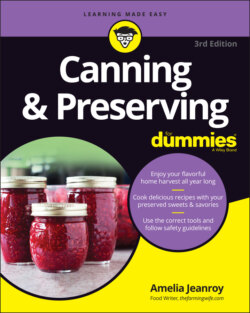Читать книгу Canning & Preserving For Dummies - Amelia Jeanroy - Страница 48
Taking a closer look at the all-important headspace
ОглавлениеWhen you’re canning food, too little headspace in your canning jars restricts your food from expanding as it boils. Inadequate space for the expanding food may force some of it out of the jar and under the lid, leaving particles of food between the seal and the jar rim. If this occurs, your jar won’t produce a vacuum seal.
Leaving too much headspace may cause discoloration in the top portion of your food. Excess headspace can keep your jar from producing a vacuum seal if the processing time isn’t long enough to exhaust the excess air in the jar.
Always use the headspace stated in your recipe. If your recipe doesn’t give you a headspace allowance, use these guidelines:
For juice, jam, jelly, pickles, relish, chutney, sauces, and condiments, leave a headspace of ¼ inch.
For high-acid foods (fruits and tomatoes), leave a headspace of ½ inch.
For low-acid foods (vegetables, meats, fish, and poultry), leave a headspace of 1 inch.
Headspace is also important when you’re freezing food because frozen food expands during the freezing process. If you fail to leave the proper headspace in your freezer container, the lid may be forced off the container, or the container may crack or break. When your frozen food comes in direct contact with the air in your freezer, the quality of your food deteriorates, and the food develops freezer burn (go to Chapter 13 for more on freezing food). On the other hand, too much air space allows excess air in your container. Even though your food doesn’t come in direct contact with the air in the freezer, the excess space in the top of the container develops ice crystals. When your food thaws, the excess liquid reduces the food’s quality.
If you don’t trust yourself to eyeball the headspace, use a small plastic ruler (about 6 inches long) to measure the correct headspace in the jar.
